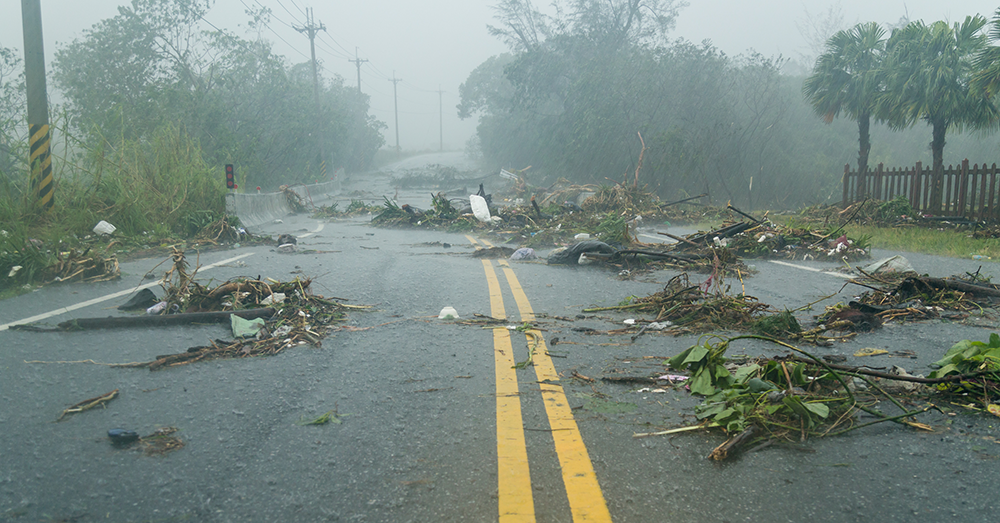Safety kits help drivers weather the storm

Florida troopers and other state emergency crews sprang to action in August as Hurricane Isaac spun madly toward their state. They alerted motorists about the dangers of travel and encouraged them stay off the road—not an easy thing to do.
How can drivers prepare for the unexpected? What kinds of emergency items should they carry in the trunk of their vehicle?
“Always check the weather and traffic conditions before you travel,” Capt. Nancy Rassmussen of the Florida Highway Patrol said recently. “And take a map. If we have road closures, drivers will need to take a detour.”
GPS systems are not always reliable. Weekend tornadoes such as the storms that descended on New York City can render GPS devices and smartphones useless. Moreover, the devices are unreliable for suggesting alternate routes, which may be flooded or blocked.
Emergency preparedness means taking the time to plan the journey. Being in a rush, getting distracted, overconfidence, not paying attention to weather alerts—life’s distractions prevent drivers from making sound judgments.
“Be prepared,” said Don Lauritzen at American Red Cross. “Plan your trip ahead of time. All the steps are simple but easily forgotten.”
First and foremost, drivers should carry an emergency kit at all times. A lot of the items Lauritzen and state patrollers such as Capt. Rassmussen suggest seem like common sense yet often are neglected by drivers.
For instance, an inexpensive battery-operated radio can help drivers keep in touch with emergency broadcasts. It also prevents drivers from draining their vehicle battery by running electronic devices.
“Just this last weekend I was coming back from the store and got caught in a sudden thunderstorm,” Lauritzen said of the downpour that made Washington, D.C. traffic come to a halt. “Several drivers parked their cars under an overpass for protection. If that storm had lasted for a few hours they would have been happy to have some emergency supplies while they waited it out.”
Lauritzen suggested assembling an emergency kit as a weekend project. That way you won’t forget items in the rush of packing your vehicle for travel. An inexpensive toolbox or sports bag comes in handy for packing an emergency kit.
“You can assemble one or buy one but you should always have it in your vehicle,” Lauritzen said.
Here are some of the items that Lauritzen and Capt. Rassmussen like to keep in their own emergency road kits:
-
Two or more flares. Nonflammable, battery operated flares may be easier to ignite in foul weather and less of a fire hazard, especially in dry climates such as California and Arizona.
-
Paper maps or a road atlas. Your smartphone or GPS device may not operate properly in electrical storms, hurricanes and tornadoes. An old-fashioned map can help you navigate detours or find a safe haven.
-
Inexpensive battery-operated radio or hand-crank two-way radio. These devices can help drivers stay in touch during storms rather than draining their vehicle battery by charging smartphones and other electronic devices.
-
Reflective road triangles to help motorists and emergency crews see your vehicle.
-
First aid kit, jumper cables and extra batteries.
-
LED Flashlight. They last for hours and some are designed to emit an emergency flash.
-
Jack and ground mat for changing a tire. Capt. Rassmussen suggested replacing the basic jack that came with your vehicle for a more sturdy, stable hydraulic lift.
-
Work gloves and a change of clothes in case you need to change a tire, fix a hose or make a small repair.
-
Basic repair tools and some duct tape (for temporarily repairing a hose leak).
-
A jug of water and paper towels for cleaning up.
-
Nonperishable food, drinking water and medicines.
-
Extra windshield washer fluid and replacement wiper blades.
-
Sanitation and personal hygiene items.
-
Copies of personal documents (medication list and pertinent medical information, passports, insurance policies).
-
Emergency blanket and coat, preferably wool.
-
Windshield Ice scraper and portable shovel in case your vehicle gets stuck in mud or snow.
Both Capt. Rassmussen and Lauritzen also recommend taking the time to prepare your vehicle and family for travel during fall and winter months:
-
Know the location of rest stops. For instance, Florida has rest stops every 45 freeway miles, and they provide good harbor in a sudden storm.
-
Get your battery checked and inspect its climate control system.
-
Replace wiper blades. Hot summer sun deteriorates blades. Fresh blades help prevent smearing while keep the windshield free of glare and road contaminants. Winter blades are designed to stay in contact with the windshield in heavy rain and icy conditions.
-
Clean your headlights, taillights, signal lights and windows to help you see, especially at night. Old bulbs lose their brightness at a rate of up to 25% or more per year. Bright bulbs help other drivers see your vehicle more clearly in rainy or snowy conditions.
-
Download the latest travel apps for your smartphone. A variety of different apps can help you pre-plan your outing, locate hotels, identify rest stops and give you road conditions. The Red Cross First Aid App contains videos and step-by-step advice for emergencies.
Useful links:
American Red Cross safety guide:
http://www.redcross.org/prepare/disaster/highway-safety
American Red Cross emergency mobile apps:
http://www.redcross.org//prepare/mobile-apps
Lousiana state’s “Get a Game Plan” program:
http://www.getagameplan.org/planFamily.htm
Florida Highway Safety tips:
http://www.flhsmv.gov/safetytips/Weather.htm
Ohio Committee for Severe Weather Awareness:
http://www.weathersafety.ohio.gov/WinterVehicleSafetyTips.aspx